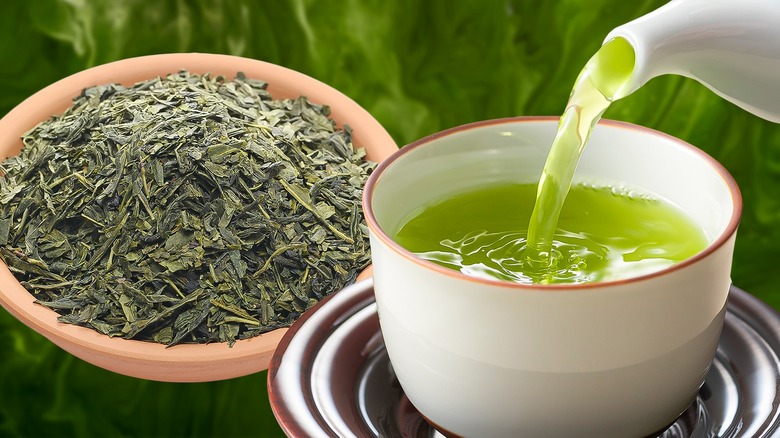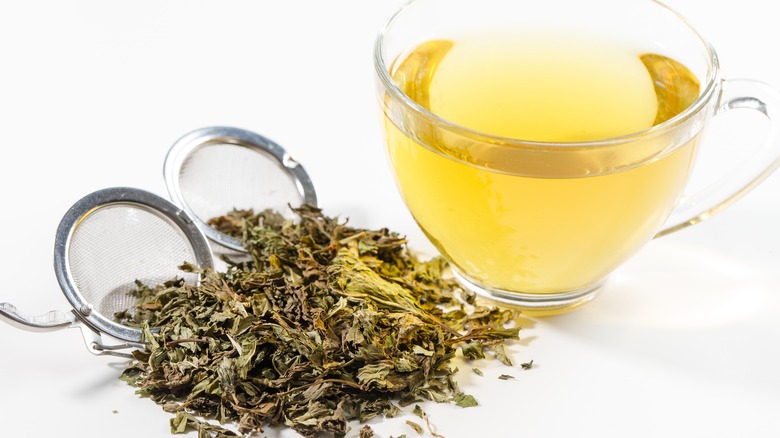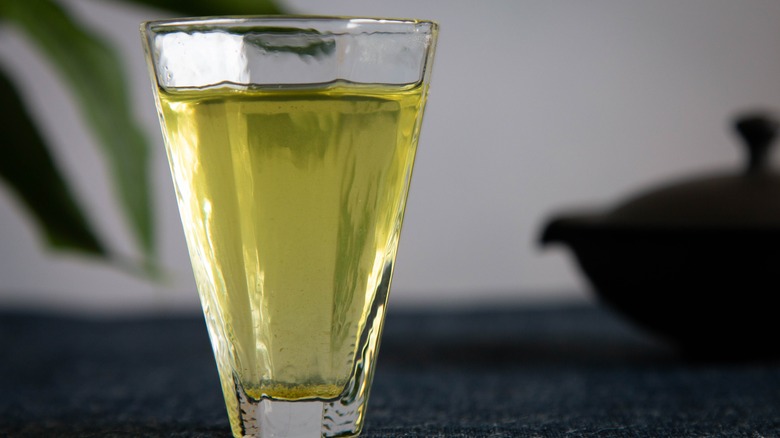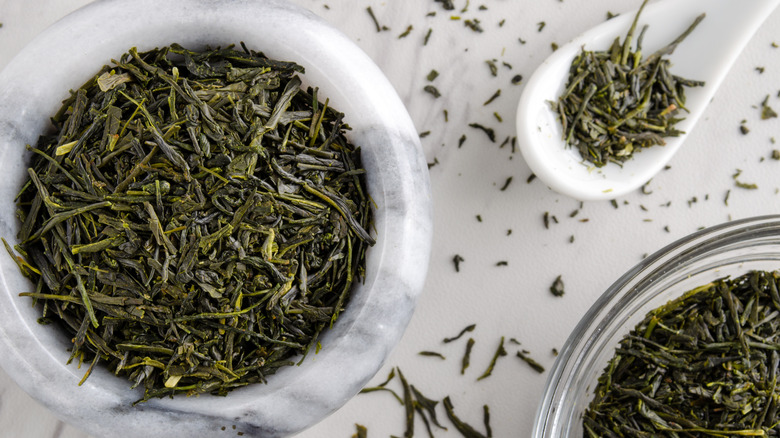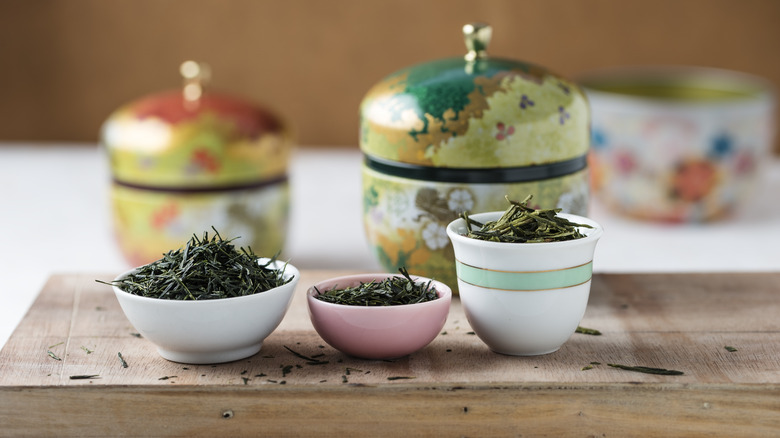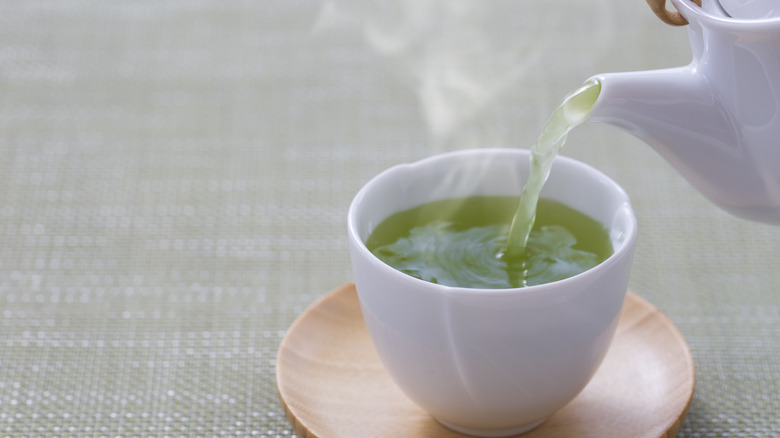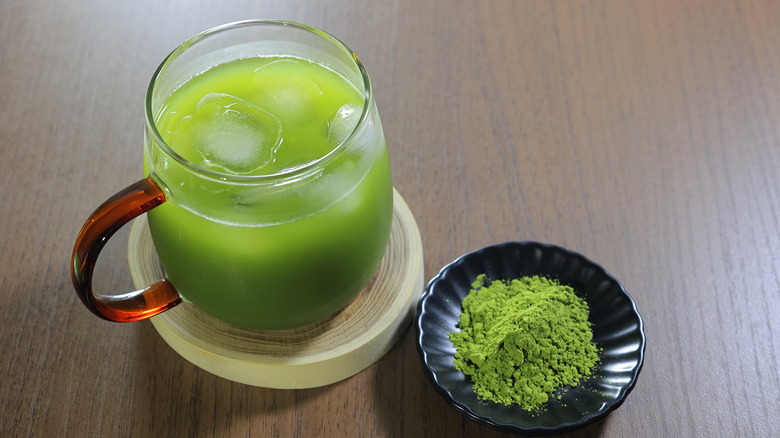6 Expert Tips And Tricks For Brewing Sencha Green Tea
If you dabble in the vast world of tea, you may have encountered sencha, a type of Japanese green tea. Japan produces primarily green tea, and sencha is the most popular tea in the country. The name "sencha" translates into English as "infused tea." But, of course, there is much more to what classifies a tea as a sencha than that. Camellia sinensis leaves are steamed, preserving their fresh flavor, and then tightly rolled. The Japanese method of steaming tea leaves instead of roasting them makes for a uniquely flavored brew. It is far more umami-forward and savory than roasted green teas, and the steaming process preserves the unique aspects of each sencha's growing conditions. It is typically slightly vegetal, with both bitter and sweet notes.
While working at Old Town Coffee, Tea, and Spice in Alexandria, Virginia, I became fascinated by the difference the steaming method makes. Unlike typical Chinese green teas, the flavor of sencha is almost broth-like, and its savory notes are much more forward than its sweet notes. If customers enjoyed green teas like gunpowder or dragonwell, I would always ask if they've tried sencha; if not, I'd make them a cup.
Sencha may be broadly categorized as a green tea, but it has its quirks and distinctive qualities. If you become familiar with them, you'll be much more likely to make yourself a great cup of tea.
Keep the steeping time short
Green tea generally has a suggested brewing temperature of around 175 degrees Fahrenheit for around two to three minutes. That time frame is pretty reliable for avoiding an over-steeped cup of tea. However, sencha is an exception to this.
Sencha leaves should be removed from the water, whether by straining or tea bag removal, after 45 seconds to one minute. This would be way early for many green teas, but the bitter notes of sencha that make it so pleasant will quickly overpower the brew if the steeping time goes beyond one minute. Tea contains catechins, a compound that makes green tea a superfood but imparts bitterness if left to over-steep. Sencha is exceptionally high in catechins because it is less processed than most green teas. That means that it becomes bitter much sooner. Some sencha teas will be perfect at closer to 45 seconds, while others will be best after a full minute. It's best to make a cup to find out.
Try it cold brewed
Sencha's savory, slightly vegetal flavor may not seem like an obvious choice for a pitcher of iced tea, but sencha is actually an excellent option for iced green tea. This is because cold water will not release the catechins in the leaves, so you can keep steeping the leaves for an extended period without any bitterness that sencha takes on rather quickly. It makes a very smooth, deeply flavorful tea. It emphasizes the umami flavor while adding a light sweetness that is absent from most hot-brewed senchas.
While the best ratios will vary depending on the type of sencha you have, it's a good idea to start with around 100 grams of cold, filtered water per gram of loose-leaf sencha. Let it steep for several hours, keeping in mind that it will get stronger over time. Filter out the tea leaves to ensure that the steeping process ends.
Go for loose-leaf tea
Tea bags are more convenient than loose-leaf tea, but there is a significant trade-off. Bagged sencha tea, while easier to find, will rarely result in a cup that can match loose-leaf varieties. There are a few reasons for this. Boxes of tea bags often contain stale tea, as the boxes on the shelves are very unlikely to be new enough to maintain freshness. Prepackaged tea bags also contain lower-quality, broken tea leaves; you won't find any elegantly rolled, finely tipped leaves in a tea bag. In fact, often, the tea in prepackaged bags is crushed into uneven pieces and even a fine powder. This means that your tea will steep unevenly, and the increased surface area will result in a frustratingly bitter cup of sencha.
Beyond the questionable tea that those tea bags hold, a big advantage of loose-leaf tea is that you can actually see and smell what you are buying. You can look for full, tightly rolled leaves and a grass-green color. A loose tea vendor is also pretty likely to be able to tell you more about the sencha, like what type of sencha it is and where it was grown.
Know what your sencha's grade means
There are a variety of grades of sencha, which differ based on their harvesting and processing. The season's first flush, or harvest, is considered the highest quality. The first flush of sencha is called ichibancha. The second flush is called nibancha, the third sanbancha, and the fourth yobancha. Beyond the harvest period of the leaves, the length of time they were steamed further categorizes sencha. Tea that has been steamed for around 30 seconds, considered to be the usual amount of time, is called futsumushi. Asamushicha is steamed for less time, and fukamushicha is steamed for a longer period.
So why does it matter? Each of these factors affects not only the flavor of the tea but also how to determine the best steeping time. Generally, the longer the leaves were steamed during processing, the richer and darker the flavor. Ideal steeping time is also on the longer end. The earlier flushes, like ichibancha and nibancha, are lighter and sweeter than the later flushes.
Keep sencha simple
Japanese green tea is prized for its umami flavor. It is decidedly savory compared to other kinds of green tea. Sencha, with its minimal processing, also preserves the terroir of the environment in which it was grown, resulting in a huge variety of flavor notes and aromas. Because of its earthy notes, sencha is not an optimal tea for flavored or fruity blends.
While some green teas, like gunpowder or dragonwell, are light and floral enough to pair well with fruit or other sweet flavorings, sencha's earthy flavor clashes with them. But that doesn't mean sencha can't be a part of any blend at all. Sencha is the base for genmaicha, a popular Japanese blend. Sencha tea is combined with toasted brown rice, and some of the rice puffs into fluffy white kernels, giving genmaicha the nickname "popcorn tea." Its warm, nutty flavor and aroma match perfectly with the savory profile of Sencha.
Try matcha iri sencha for the best of both worlds
Matcha has exploded in popularity in recent years, and most cafes now carry it. You can't say the same for sencha. But really, they have a lot in common. They are both Japanese steamed green teas. Matcha is made up of tea leaves grown in the shade, which gives it a deeper green color. Those leaves are then ground into a fine powder that, rather than being strained out, dissolves into the hot water. Matcha has a heavier, earthy, sweet flavor, while sencha is savory and brothy.
The two come together in matcha iri sencha, a blend of whole sencha leaves and matcha powder. When steeped, the powder coating the leaves immediately dissolves into the hot water, while the leaves infuse their flavor over time. The result is a uniquely robust, grassy, and complex cup of tea that showcases what makes Japanese tea great. Since both matcha and sencha are excellent cold, this blend is also a great option for an iced matcha.
